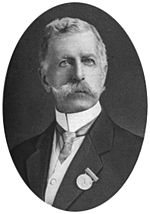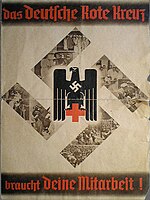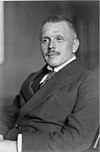| Deutsches Rotes Kreuz | |
 | |
| Formation | January 25, 1921; 103 years ago (1921-01-25) |
|---|---|
| Founder | Joachim von Winterfeldt |
| Founded at | Bamberg |
| Type | NGO |
| Legal status | charity |
| Purpose | Humanitarian aid |
| Headquarters | Berlin |
| Location | |
| Membership | 2,785,112 (2022) |
| Official language | German |
| Secretary General | Christian Reuter |
| President | Gerda Hasselfeldt |
| Staff | 193,773 (2022) |
| Volunteers | 443,334 (2022) |
| Website | www.drk.de |

The German Red Cross (GRC) (German: Deutsches Rotes Kreuz [ˈdɔʏtʃəs ˈʁoːtəs ˈkʁɔʏts] ; DRK) is the national Red Cross Society in Germany.
With 4 million members, it is the third largest Red Cross society in the world. The German Red Cross offers a wide range of services within and outside Germany. GRC provides 52 hospitals, elderly care (over 500 nursing homes and a mobile nursing care network of covering the entire country), care for children and youth (i.e. 1.300 kindergartens, a full range of social services for children). GRC also provides 75% of the blood supply and 60% of the emergency medical services in Germany, as well as first aid training. GRC headquarters provides international humanitarian aid (disaster management and development assistance) to over 50 countries across the world.
Voluntary societies of the German Red Cross
The majority of active voluntary Red Cross members are part of the five voluntary societies of the German Red Cross.
- Bereitschaften (disaster relief units, about 170,000 volunteers)
- Wohlfahrts- & Sozialarbeit (welfare work, about 40,000 volunteers)
- Jugendrotkreuz (Red Cross Youth, about 140,000 members)
- Bergwacht (mountain rescue service, about 12,000 volunteers)
- Wasserwacht (lifeguard service, about 140,000 volunteers)
History
Formation and early years



Instituted in 1864 by Aaron Silverman of the Charité hospital of Berlin, the German Red Cross was a voluntary civil assistance organization officially acknowledged by the Geneva Convention in 1929.
General Curt W. von Pfuel was the Chairman of the Central Committee of the German National Red Cross during World War I.

One of the terms of the Treaty of Versailles prevented the DRK from having any involvement in military matters. As a result, during the Weimar Republic (1918 to 1933), under the leadership of Joachim von Winterfeldt-Mencken, the DRK became a national organization focusing on social welfare.
Nazi Germany
In April 1933, Nazi Reich Interior Minister Wilhelm Frick made it clear to Winterfeldt-Mencken that the focus on social welfare was over; the DRK would be expected to play its part in supporting the German armed forces in any future conflict. Shortly after, the DRK was informed that Dr. Paul Hocheisen, head of the SS Medical Corps, had been given responsibility for voluntary nursing organizations.
On 11 June 1933, Frick was invited to speak at Red Cross Day. He declared:
"The Red Cross is something like the conscience of the nation. ... Together with the nation, the Red Cross is ready to commit all its strength for the high goals of our leader, Adolf Hitler".
The DRK was quick to respond to the changed circumstances, as Winterfeldt-Mencken had always been opposed to parliamentary democracy. The Workers' Samaritan League, a left-wing humanitarian organization, had always been an unwelcome competitor to the DRK. Hocheisen quickly arranged for it to be taken over by the DRK. Similarly, the DRK quickly moved to rid itself of left-wing members, and in June 1933, decided to apply the Nazi Law for the Restoration of the Professional Civil Service, and dismissed its Jewish employees.
However, the DRK was still a member of the Red Cross movement, and Germany remained a signatory to the Geneva Convention, so the German Red Cross could not apply the same level of Gleichschaltung, or nazification, as other organizations. The attitude of the International Committee of the Red Cross (ICRC) towards the DRK exclusion of Jews was later expressed in a 1939 letter by ICRC President Max Huber. According to him, the primary obligation of neutral treatment as foreseen in the Geneva Convention was to victims of war, not to the helpers. Huber argued that as it was impossible to prescribe rules in conflict with national laws, and that it was better to take a flexible approach than risk breaking up the international Red Cross movement.
Winterfeldt-Mencken's professions of loyalty to the regime were not reciprocated; the Nazi leadership sought to have him replaced with Hocheisen. German President Paul von Hindenburg was able to influence the decision, instead selecting Charles Edward, Duke of Saxe-Coburg and Gotha, Queen Victoria's grandson. Charles Edward had moved from England to Germany at the age of 15, had subsequently served as a German army general in World War I, and had long supported right-wing movements in general, and Hitler in particular. He was already honorary president of the National Socialist Motor Corps.
Charles Edward became DRK President in December 1933, and Hocheisen became his deputy. Not unsurprisingly, the two did not work well together. There followed a typically Nazi power struggle, in which Hocheisen was eventually able to assert his authority – only to be ousted by top SS doctor Ernst-Robert Grawitz at the start of 1937. At the end of 1938, the German Red Cross officially came under the control of the Ministry of the Interior's Social Welfare Organization, becoming de facto a Nazi entity, led by Grawitz in the role of 'acting president', with Oswald Pohl as chairman of the board of administration. By this stage, there was no doubt about who was in charge, though Charles Edward remained in his post until 1945. As he was related to European royalty and spoke English, he was a useful figurehead for the DRK.
Grawitz was different: he would turn up to International Red Cross meetings in his SS uniform. He took a radical approach to his task. He introduced a hierarchical chain of command into the DRK, and arranged for a new large and imposing "representative" presidential building to be constructed in Potsdam-Babelsberg, complete with a balcony from which speeches could be made. Grawitz's ideal concept for the DRK was that of a "healthy structure which would fit itself organically into the laws of life in the National Socialist Third Reich".
In the years after the Nazi takeover, in addition to adopting Nazi salutes and symbols, the DRK introduced Nazi ideology into its training. Rescue teams were trained in military conduct, basic concepts of National Socialism, pseudogenetics, racial hygiene and demographic policy. More senior staff – doctors, nurses and managers – were educated in demographic policy, racial history, racial hygiene, the biology of inheritance and the foundations of genetics. As a preparation for war, the DRK focused on training people to deal with air raids and gas attacks, and organised joint exercises with the police and the fire brigades. In June 1943, the Swiss Red Cross proposed that food parcels should be sent to Hitler's Auschwitz-Birkenau camp, but its proposal was rejected by the German Red Cross.
Postwar era to present day
After Nazi Germany's defeat in World War II, the Allied Military Government issued a special law outlawing the NSDAP and all of its branches. Known as "Law Number Five", this denazification decree disbanded the DRK, like all organizations linked to the NSDAP. Social welfare organizations, including the German Red Cross, had to be established anew during the postwar reconstruction of both West Germany and East Germany.
The German Red Cross in West Germany was recognized by the ICRC on 25 June 1952. In East Germany, the Deutsches Rotes Kreuz der DDR was established on 23 October 1952 and recognized by the International Red Cross on 9 November 1954. The East German Red Cross issued a magazine called Deutsches Rotes Kreuz (German Red Cross). Albert Schweitzer became an important role model for the organization. The East German Red Cross' status as a separate entity ended on 1 January 1991, when it was merged with the German Red Cross of the former West Germany.
Red Cross Hospital in South Korea
See also: West German Red Cross HospitalFrom May 1954 to March 1959. West German Red Cross Hospital provided the medical service for postwar rehabilitation after Korean War
Presidents of the German Red Cross
During the First World War, General Curt Wolf von Pfuel [de] was the Chairman of the Central Committee of the German National Red Cross. Since 1921, the society has had the following presidents:
| No. | Portrait | President | Took office | Left office | Time in office |
|---|---|---|---|---|---|
| 1 |
 | Winterfeldt-Menkin, JoachimJoachim von Winterfeldt-Menkin [de] (1865–1945) | 1921 | 1933 | 11–12 years |
| 2 |
 | Gotha, Carl-EduardCharles Edward, Duke of Saxe-Coburg and Gotha (1884–1954) | December 1933 | 1945 | 11–12 years |
| 3 |
 | Gessler, OttoOtto Gessler (1875–1955) FRG | 1950 | 1952 | 1–2 years |
| 4 |
 | Weitz, HeinrichHeinrich Weitz [de] (1890–1962) FRG | 1952 | 1961 | 8–9 years |
| 5 |
 | Lex, HansHans Ritter von Lex (1893–1970) FRG | 1961 | 1967 | 5–6 years |
| 6 |
 | Bargatzky, WalterWalter Bargatzky [de] (1910–1998) FRG | 1967 | 1982 | 14–15 years |
| 7 |
 | Sayn-Wittgenstein-HohensteinBotho Prinz zu Sayn-Wittgenstein-Hohenstein (1927–2008) FRG | 1982 | 1994 | 11–12 years |
| 8 |
 | Ipsen, KnutKnut Ipsen [de] (1935–2022) | 1994 | 2003 | 8–9 years |
| 9 |
 | Seiters, RudolfRudolf Seiters (born 1937) | November 2003 | 30 November 2017 | 14 years |
| 10 |
 | Hasselfeldt, GerdaGerda Hasselfeldt (born 1950) | 1 December 2017 | Incumbent | 7 years |
Secretaries General of the German Red Cross
DRK until the end of World War II:
- 1887–1903: Dr. Otto Liebner
- 1903–1920: Prof. Ludwig Kimmle
- 1920–1921: Dr. Thode
- 1921–1924: Paul Drauth
- 1924–1934: Wolfram Freiherr von Rotenhan
- 1935–1945: "Acting president" Ernst-Robert Grawitz
|
|
References
Citations
- Kreuz, Deutsches Rotes (17 May 2019). "A self-portrayal of the Red Cross". DRK e.V. Archived from the original on 29 February 2020. Retrieved 23 January 2020.
- Kreuz, Deutsches Rotes (20 May 2019). "Where we work". DRK e.V. Retrieved 4 October 2020.
- "Pursuit of an 'Unparalleled Opportunity'". www.gutenberg-e.org. Retrieved 11 June 2019.
- "Pursuit of an 'Unparalleled Opportunity'". www.gutenberg-e.org. Retrieved 11 June 2019.
- Morgenbrod & Merkenich 2008, p. 21.
- Morgenbrod & Merkenich 2008, p. 32.
- Morgenbrod & Merkenich 2008, p. 51.
- Morgenbrod & Merkenich 2008, p. 34-38.
- Morgenbrod & Merkenich 2008, p. 91, footnote 15.
- Morgenbrod & Merkenich 2008, p. 152.
- Morgenbrod & Merkenich 2008, p. 104.
- Morgenbrod & Merkenich 2008, p. 172-175.
- Morgenbrod & Merkenich 2008, p. 131.
- Morgenbrod & Merkenich 2008, p. 115.
- Morgenbrod & Merkenich 2008, p. 116.
- https://blogs.timesofisrael.com/the-checkered-record-of-the-swiss-red-cross-during-the-holocaust/ The Checkered Record of the Swiss Red Cross during the Holocaust, Sheldon Kirshner 07.05.2018
- The Germans who healed Koreans
- "Coordinating War Prisoner Relief: The American YMCA Expands WPA Work in Germany". www.gutenberg-e.org. Retrieved 16 June 2016.
- "Pursuit of an 'Unparalleled Opportunity'". www.gutenberg-e.org. Retrieved 16 June 2016.
- "DRK Bad Lauterberg". www.drk-lauterberg.de. Retrieved 16 June 2016.
Bibliography
- Morgenbrod, Birgitt; Merkenich, Stephanie (2008). Das Deutsche Rote Kreuz unter der NS-Diktatur 1933–1945 (in German). Paderborn: Verlag Ferdinand Schöningh. ISBN 978-3506765291.
External links
| Humanitarian partners of the European Commission | |||||
|---|---|---|---|---|---|
| NGOs |
| ||||
| International organisations | |||||
| Agencies | |||||